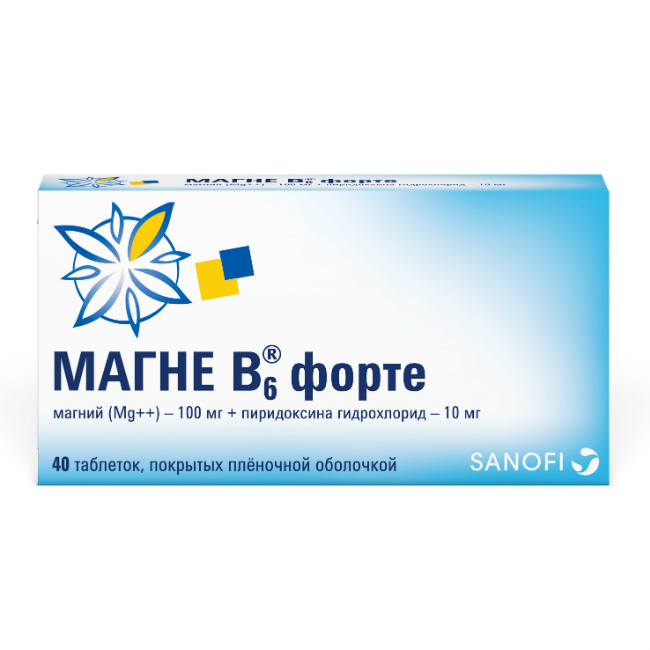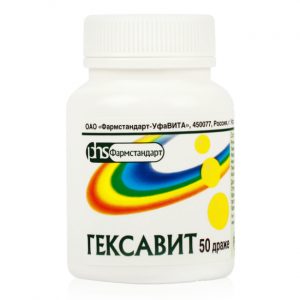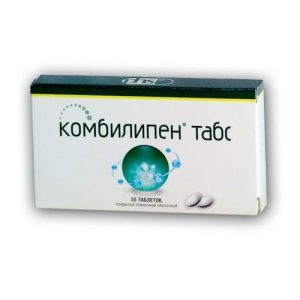Description
Pharmacological action of
Pharmacodynamics of
Magnesium is a vital element in the functioning of metabolism, which is a vital element in the functioning of cells, which is essential for the normal functioning of cells. In particular, It is involved in the regulation of transmission of nerve impulses and in muscle contraction. 1/3 of the amount of magnesium in the body accumulates in the bone tissue. The body receives magnesium along with food. A lack of magnesium in the body can be observed with a violation of the diet (diet), with an increase in the need for magnesium or with an imbalance in the intake, metabolism and excretion of magnesium (for example, with increased physical and mental stress, stress, during pregnancy, with the use of diuretics).
Pyridoxine (Vitamin B6) is involved in many metabolic processes and helps to improve the absorption of magnesium from the gastrointestinal tract and its penetration into cells.
Serum magnesium levels:
Between 12 and 17 mg / L (1 – 1.4 mEq / L or 0.5 – 0.7 mmol / L): indicate moderate magnesium deficiency
Below 12 mg / L (1 mEq / l or 0, 5 mmol / L): indicate a severe magnesium deficiency.
Pharmacokinetics
Gastrointestinal absorption of magnesium salts occurs in part by a passive mechanism in which salt solubility plays a decisive role. The degree of this absorption does not exceed 50%. Excretion occurs mainly by the kidneys.
Indications
Estimated magnesium deficiency, isolated or associated with other deficient conditions, accompanied by symptoms such as:
increased irritability,
minor sleep disturbances,
gastrointestinal cramps,
palpitations, srdlmkp muscle
tingling sensation in muscles.
If after a month of treatment there is no decrease in these symptoms, continued treatment is impractical.
Contraindications
Hypersensitivity to the components of the drug.
Severe renal failure (creatinine clearance less than 30 ml / min).
Phenylketonuria.
Age up to 6 years (efficacy and safety not established).
Hereditary galactosemia, glucose and galactose malabsorption syndrome, or lactase deficiency (due to the presence of lactose in the formulation).
Concomitant use of levodopa (see Interaction with other drugs ).
Precautions
Moderate renal failure (danger of developing hypermagnesemia).
Special instructions
Tablets are intended only for adults and children over 6 years of age.
In moderate renal failure, the drug should be used with caution because of the risk of developing hypermagnesemia.
With a simultaneous deficiency of calcium and magnesium, the deficiency of magnesium should be replenished before taking calcium supplements or dietary supplements containing calcium.
When using pyridoxine in high doses (more than 200 mg per day) for a long time (for several months or, in some cases, years), sensory axonal neuropathy may develop, which is accompanied by symptoms such as numbness and impaired proprioceptive sensitivity, distal tremor parts of the extremities and gradually developing sensory ataxia (impaired coordination of movements). These disorders are usually reversible and disappear after you stop taking vitamin B6.
Impact on the ability to drive vehicles and engage in other potentially dangerous activities
Not affected. There are no special recommendations.
Composition of
1 tablet contains
Core of the tablet:
active ingredients: magnesium citrate – 618.43 mg, which corresponds to 100 mg of magnesium (mg ++),
pyridoxine hydrochloride – 10.00 mg
excipients: lactose – 50.57 mg,
macrogol-6000 – 120.00 mg,
magnesium stearate – 1.00 mg.
shell tablets:
hypromellose 6 mPa.s – 14.08 mg,
macrogol-6000 – 1.17 mg,
titanium dioxide (E 171) – 4.75 mg,
talcum – traces.
Dosage and administration
Tablets should be taken whole with a glass of water.
Adults: 3-4 tablets per day, divided into 2-3 doses, with meals.
Children over the age of 6 years (weighing about 20 kg):
10-30 mg / kg / day (0.4 1.2 mmol / kg / day), that is, children over 6 years old (weighing about 20 kg) 2-4 tablets per day, divided into 2-3 doses, with meals.
Typically, the duration of treatment is one month.
Side effects of
Immune system disorders:
Very rare (<0.01%): allergic reactions, including skin reactions Gastrointestinal disorders: Unknown frequency (reported frequency of occurrence is not possible ): diarrhea, abdominal pain, nausea, vomiting, flatulence. Storage conditions Store at a temperature not exceeding 30 ° C. Keep out of the reach of children. Expiration 2 years. Deystvuyuschee substances magnesium, pyridoxine Terms and conditions without prescription dosage form tablets




